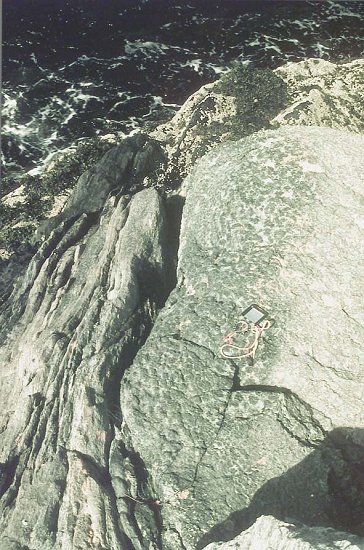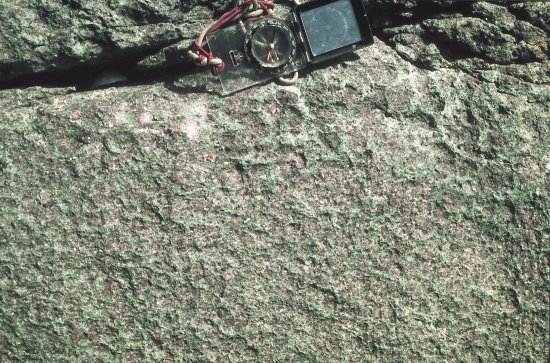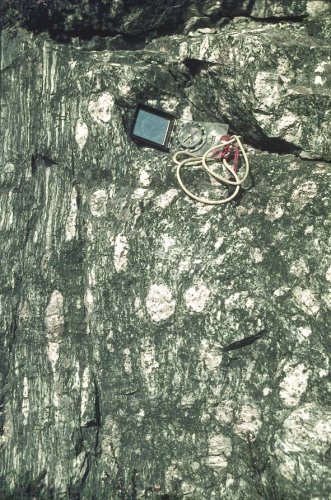
Pre-cursor conditions:
The WGR started at granulite facies (ancient). Therefore the rocks were most probably dry at the start of crustal thickening associated with Caledonian mountain building. Dry rocks like this have a good chance of remaining inert, preserving metastable mineral associations.
But at what crustal depth did these rocks start?
In the Flatraket body : P = 10-12 kbar, c. 800.C
These early assemblages have been dated at c. 1700 Ma.
Note: there is no evidence that the rocks ever melted (therefore they did not cross the granite dry melt reaction). These early assemblages were preserved as meta-stable during eclogite-facies metamorphism in the WGR.
Elsewhere within the area not so far from Flatraket, garnets include inclusions of microdiamond (e.g. at Fjortoft)

![]() A
metabasic pod embedded in gneisses of intermediate composition. The pod was
relatively resistant to deformation (it was more competent). It has preserved
UHP mineral assemblages. Presumably the surrounding gneisses also once had UHP
minerals. However, these have been completely overprinted by amphibolite-greenschist
facies assemblages associated with substantial later deformation.
A
metabasic pod embedded in gneisses of intermediate composition. The pod was
relatively resistant to deformation (it was more competent). It has preserved
UHP mineral assemblages. Presumably the surrounding gneisses also once had UHP
minerals. However, these have been completely overprinted by amphibolite-greenschist
facies assemblages associated with substantial later deformation.

![]()
This green and pink rock is classic eclogite of metabasic composition. The green
mineral is the pyroxene omphacite while the pink mineral is the garnet
pyrope. Within the pyrope at this locality are preserved inclusions of
coesite although more commonly the coesite has inverted to its lower
pressure polymorph, quartz. Note that the garnet-omphacite texture here is not
associated with a shape fabric perhaps implying mineral growth at peak UHP conditions
- at least in this rock - was not accompanied by deformation. You can use the
occurrence of coesite in garnet here to plot a minimum position for these rocks
in PT space at the time of peak burial (pressure). If you assume that all garnet
growth occurred at these peak conditions, crystallisation (Sm-Nd) ages on the
garnet can be used to date this "event" in the history of the rock.

![]() Deformed augen gneiss - part of a tonalite body that lies within the Western
Gneisses. This unit is related to the original formation of the continental
crust here (c. 1700 Ma) and is associated with granulite facies metamorphism
(peak conditions here of P = 10-12 kbar, T= c.800°C). This left the rocks
dry and relatively inert, making them less susceptible to subsequent deformation
and UHP metamorphism. They travelled, with the basic pods, to great depth but
presumably remain metastable throughout. It is likely that these began the Caledonian
orogeny as part of the lower continental crust (of Baltica) - perhaps at 8-10
kbar and at about 600C. Of course all of these rocks now reside at the Earth's
surface, a location they must just about have reached by mid Devonian times.
Deformed augen gneiss - part of a tonalite body that lies within the Western
Gneisses. This unit is related to the original formation of the continental
crust here (c. 1700 Ma) and is associated with granulite facies metamorphism
(peak conditions here of P = 10-12 kbar, T= c.800°C). This left the rocks
dry and relatively inert, making them less susceptible to subsequent deformation
and UHP metamorphism. They travelled, with the basic pods, to great depth but
presumably remain metastable throughout. It is likely that these began the Caledonian
orogeny as part of the lower continental crust (of Baltica) - perhaps at 8-10
kbar and at about 600C. Of course all of these rocks now reside at the Earth's
surface, a location they must just about have reached by mid Devonian times.
Western Gneiss Region front page : Introduction : Hornelen
map : Hornelen Basin N-S section